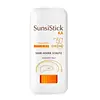What's inside
What's inside
 Key Ingredients
Key Ingredients

 Benefits
Benefits

 Concerns
Concerns

 Ingredients Side-by-side
Ingredients Side-by-side

Octyldodecanol
EmollientTitanium Dioxide
Cosmetic ColorantSynthetic Wax
AbrasiveBis-Diglyceryl Polyacyladipate-2
EmollientButylene Glycol Cocoate
EmulsifyingZinc Oxide
Cosmetic ColorantCera Alba
EmollientCI 77891
Cosmetic ColorantHydrogenated Castor Oil
EmollientDipentaerythrityl Tetrahydroxystearate/Tetraisostearate
Skin ConditioningStearic Acid
CleansingAlumina
AbrasiveWater
Skin ConditioningMica
Cosmetic ColorantRicinus Communis Seed Oil
MaskingTocopheryl Acetate
AntioxidantButyrospermum Parkii Butter
Skin ConditioningCI 77492
Cosmetic ColorantTriethoxycaprylylsilane
CI 77491
Cosmetic ColorantAscorbyl Palmitate
AntioxidantOctyldodecanol, Titanium Dioxide, Synthetic Wax, Bis-Diglyceryl Polyacyladipate-2, Butylene Glycol Cocoate, Zinc Oxide, Cera Alba, CI 77891, Hydrogenated Castor Oil, Dipentaerythrityl Tetrahydroxystearate/Tetraisostearate, Stearic Acid, Alumina, Water, Mica, Ricinus Communis Seed Oil, Tocopheryl Acetate, Butyrospermum Parkii Butter, CI 77492, Triethoxycaprylylsilane, CI 77491, Ascorbyl Palmitate
Octyldodecanol
EmollientPolyethylene
AbrasiveButylene Glycol Cocoate
EmulsifyingHydrogenated Microcrystalline Wax
Emulsion StabilisingBis-Ethylhexyloxyphenol Methoxyphenyl Triazine
Skin ConditioningDiethylamino Hydroxybenzoyl Hexyl Benzoate
UV FilterDiethylhexyl Butamido Triazone
UV AbsorberButyl Methoxydibenzoylmethane
UV AbsorberEthylhexyl Salicylate
UV AbsorberBeeswax
Emulsion StabilisingHydrogenated Castor Oil
EmollientWater
Skin Conditioning1,2-Hexanediol
Skin ConditioningAluminum Hydroxide
EmollientButylene Glycol
HumectantCaprylic/Capric Triglyceride
MaskingCaprylyl Glycol
EmollientCichorium Intybus Root Extract
MaskingDisodium Stearoyl Glutamate
CleansingMethyl Methacrylate Crosspolymer
Oxothiazolidine
Skin ProtectingSaccharin
MaskingSodium Benzoate
MaskingCI 77891
Cosmetic ColorantTocopheryl Glucoside
EmollientOctyldodecanol, Polyethylene, Butylene Glycol Cocoate, Hydrogenated Microcrystalline Wax, Bis-Ethylhexyloxyphenol Methoxyphenyl Triazine, Diethylamino Hydroxybenzoyl Hexyl Benzoate, Diethylhexyl Butamido Triazone, Butyl Methoxydibenzoylmethane, Ethylhexyl Salicylate, Beeswax, Hydrogenated Castor Oil, Water, 1,2-Hexanediol, Aluminum Hydroxide, Butylene Glycol, Caprylic/Capric Triglyceride, Caprylyl Glycol, Cichorium Intybus Root Extract, Disodium Stearoyl Glutamate, Methyl Methacrylate Crosspolymer, Oxothiazolidine, Saccharin, Sodium Benzoate, CI 77891, Tocopheryl Glucoside
 Reviews
Reviews

Ingredients Explained
These ingredients are found in both products.
Ingredients higher up in an ingredient list are typically present in a larger amount.
Butylene Glycol Cocoate isn't fungal acne safe. It can be bad for dry skin.
Ci 77891 is a white pigment from Titanium dioxide. It is naturally found in minerals such as rutile and ilmenite.
It's main function is to add a white color to cosmetics. It can also be mixed with other colors to create different shades.
Ci 77891 is commonly found in sunscreens due to its ability to block UV rays.
Learn more about CI 77891Hydrogenated Castor Oil is created by adding hydrogen to castor oil. This helps stabilize the castor oil and raises the melting point. At room temperature, hydrogenated castor oil is solid.
Castor Oil helps moisturize the skin. It is rich in a fatty acid called ricinoleic acid. This fatty acid helps prevent moisture loss on the skin. This helps keep your skin soft and hydrated. Ricinoleic acid also has anti-inflammatory and pain reducing properties.
As a wax-like substance, Hydrogenated Castor Oil acts as an emollient. Emollients help keep your skin stay soft and smooth by creating a barrier. This barrier helps trap moisture.
Hydrogenated Castor Oil may not be fungal-acne safe. We recommend speaking with a professional.
Learn more about Hydrogenated Castor OilOctyldodecanol is a fatty alcohol. It is primarily used to enhance the texture of products.
As an emulsifier, Octyldodecanol helps prevent the oils and waters from separating. It also prevents ingredients from creating foam when shaken.
Octyldodecanol is created by reducing fatty acid to an alcohol.
Due to its high molecular weight, it does not get absorbed into the skin.
Learn more about OctyldodecanolWater. It's the most common cosmetic ingredient of all. You'll usually see it at the top of ingredient lists, meaning that it makes up the largest part of the product.
So why is it so popular? Water most often acts as a solvent - this means that it helps dissolve other ingredients into the formulation.
You'll also recognize water as that liquid we all need to stay alive. If you see this, drink a glass of water. Stay hydrated!
Learn more about Water